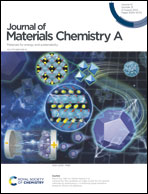A novel polyelectrolyte-based artificial light-harvesting system for photocatalysis of cross-dehydrogenation coupling†
Abstract
Artificial light-harvesting systems usually utilize a variety of noncovalent interactions and so their assembly processes are more complex. Building an artificial light-harvesting system with polyelectrolyte materials via only electrostatic interactions is a more easy and effective method. In this work, we designed and synthesized a tetraphenylene derivative (4PyTPE) which self-assembled into positively charged nanoparticles in aqueous solution (pH = 2). An anionic polyelectrolyte material poly(sodium 4-styrene sulfonate) (RSS) was utilized to construct an artificial light-harvesting system with 4PyTPE and rhodamine B (RhB) via electrostatic interactions between anions and cations. When the molar ratio of 4PyTPE-RSS/RhB was 100 : 3, the energy transfer efficiency (ΦET) and antenna effect (AE) were calculated to be 56.8% and 4.09, respectively. Moreover, for the first time, an artificial light-harvesting system constructed from a polyelectrolyte material was applied for the photocatalysis of cross-coupling dehydrogenation (CDC) reactions in aqueous solution with high yields of up to 90%. This work advances the promising application of artificial light-harvesting systems based on polyelectrolyte materials for photocatalysis.



 Please wait while we load your content...
Please wait while we load your content...